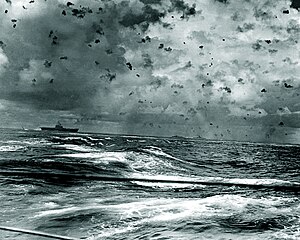| This article includes a list of references, related reading, or external links, but its sources remain unclear because it lacks inline citations. Please help improve this article by introducing more precise citations. (April 2013) (Learn how and when to remove this message) |
| Task Force 16 | |
|---|---|
 Task Force 16 with Enterprise (center left) and battleship South Dakota (distant background) under Japanese carrier air attack during the great Battle of the Santa Cruz Islands on 26 October 1942. Task Force 16 with Enterprise (center left) and battleship South Dakota (distant background) under Japanese carrier air attack during the great Battle of the Santa Cruz Islands on 26 October 1942. | |
| Country | United States |
| Allegiance | Allies of World War II |
| Branch | United States Navy |
| Type | Naval aviation unit |
| Role | Aircraft carrier support |
| Engagements | Marshalls-Gilberts raids Doolittle Raid Battle of Midway Battle of the Eastern Solomons Battle of the Santa Cruz Islands Naval Battle of Guadalcanal Battle of Rennell Island |
| Commanders | |
| Notable commanders | William Halsey, Jr., Raymond A. Spruance Thomas Kinkaid |
Task Force 16 (TF 16) was one of the most storied task forces in the United States Navy, a major participant in a number of the most important battles of the Pacific War.
In July 1941, USS Wasp (CV-7) drew the assignment of ferrying army aircraft to Iceland because of a lack of British aircraft to cover the American landings. The American P-40s would provide the defensive fighter cover necessary to watch over the initial American occupying forces. Wasp slipped out to sea on 28 July, with the destroyers O'Brien and Walke as plane guards. The heavy cruiser Vincennes later joined the formation at sea.
Within a few days, Wasp's group joined the larger Task Force 16—consisting of the battleship Mississippi, the heavy cruisers Quincy and Wichita, five destroyers, the auxiliary Semmes, the attack transport American Legion, the stores ship Mizar, and the amphibious cargo ship Almaack. Those ships, too, were bound for Iceland with the first occupation troops embarked. On the morning of 6 August, Wasp, Vincennes, Walke, and O'Brien parted company from Task Force 16 (TF 16). Soon thereafter, the carrier turned into the wind and commenced launching the planes from the 33rd Pursuit Squadron. As the P-40s and the trio of trainers droned on to Iceland, Wasp headed home for Norfolk, her three escorts in company. After another week at sea, the group arrived back at Norfolk on 14 August.
The Task Force was re-formed in mid-February 1942 around Enterprise (CV-6), with Vice Admiral William F. Halsey in command of the force, and supported by cruisers Salt Lake City (CA-25) and Northampton (CA-26), along with a half-dozen destroyers.
The task force's first mission was to shell Wake Island and Marcus Island, then, joined by Hornet (CV-8) and the rest of Task Force 18 (TF18), in April the force conducted the Doolittle Raid on Tokyo. In May Halsey was ordered to join Task Force 17 (TF17) in the Coral Sea, but the Battle of the Coral Sea was over before TF 16 could join in.
Halsey was then hospitalized with a skin disease, so Rear Admiral Raymond A. Spruance took over TF 16 and along with TF 17, led it to victory in the Battle of Midway.
In August, the task force supported the landings on Guadalcanal, then fought in the Battle of the Eastern Solomons, followed by the great Battle of the Santa Cruz Islands in October, the Naval Battle of Guadalcanal in November, and covered the retreat of TF 18 after the Battle of Rennell Island.
In March 1943, TG 16.6 fought the Battle of the Komandorski Islands, then bombarded Attu in April, and the whole force supported the recapture of the Aleutians in the Battle of Attu.
In 1944 and 1945, the task force was a refueling unit consisting of destroyer escorts and oilers.
References
Books
- Lundstrom, John B. (2006). Black Shoe Carrier Admiral: Frank Jack Fletcher at Coral Sea, Midway, and Guadalcanal. Annapolis, Maryland: Naval Institute Press. ISBN 1-59114-475-2.
- Lundstrom, John B. (2005). First Team and the Guadalcanal Campaign: Naval Fighter Combat from August to November 1942 (New ed.). Naval Institute Press. ISBN 1-59114-472-8.
- Lundstrom, John B. (2005). The First Team: Pacific Naval Air Combat from Pearl Harbor to Midway (New ed.). Annapolis, Maryland, U.S.A.: Naval Institute Press. ISBN 1-59114-471-X.
- Morison, Samuel Eliot (2001) . The Rising Sun in the Pacific 1931 – April 1942, vol. 3 of History of United States Naval Operations in World War II. Castle Books. ISBN 0-7858-1304-7.
- Morison, Samuel Eliot (2001) . Coral Sea, Midway and Submarine Actions, May 1942 – August 1942, vol. 4 of History of United States Naval Operations in World War II. Champaign, Illinois, US: University of Illinois Press. ISBN 0-252-06995-1.
- Morison, Samuel Eliot (1958). The Struggle for Guadalcanal, August 1942 – February 1943, vol. 5 of History of United States Naval Operations in World War II. Boston: Little, Brown and Company. ISBN 0-316-58305-7.
- Stafford, Edward P. (2002). The Big E: The Story of the USS Enterprise (reissue ed.). Naval Institute Press. ISBN 1-55750-998-0.
- Stille, Mark (2007). USN Carriers vs IJN Carriers: The Pacific 1942. New York: Osprey. ISBN 978-1-84603-248-6.
Web
- United States Navy, Office of Naval Intelligence (1943). "Early Raids in the Pacific Ocean: February 1 to 10 March 1942". Combat Narrative. Publication Section, Combat Intelligence Branch.